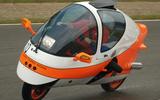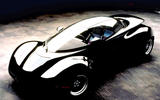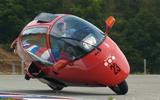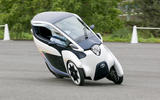 Slide of
Slide of
There are plenty of two-seat cars in the world, but only a select few place them in a tandem formation.
Whether you want the feel of a fighter plane or just like a snug cabin, tandem seat cars are unusual. Here’s our pick of the best, worst and just plain odd of these in-line seating machines, starting in chronological order:
 Slide of
Slide of
Messerschmitt (1953)
The Messerschmitt KR175 and KR200 three-wheelers used a tandem two-seat cockpit to make it as slim as possible. This helped with keeping the car small, light and efficient to make the most of its tiny engine options, though performance fans could choose the giddy power of the four-wheel TG500 Tiger.
The snug seating in the cabin was not the only quirk of this bubble car as the steering was by handlebar rather than a wheel. This gave the Messerschmitt surprising agility and several found their way into competition, though the arrival of affordable small cars like the Mini in the late 1950s sealed the German tandem-seater’s fate. Messerschmitt turned back to its first love: making aircraft.
 Slide of
Slide of
Ford Cockpit (1981)
Despite its two-in-a-row seating and name, the Ford Cockpit was more of an experiment in materials for the Blue Oval. It used aluminium for the main body with plastic employed for the upper sections and wings. There was also a large Perspex and glass canopy that hinged forwards form the top of the stubby bonnet to give access to the interior.
The rear passenger had a small roll cage to hang on to when getting in and out, but the Cockpit was cramped. Performance was also minimal thanks to a 12bhp 200cc Piaggio scooter engine providing the oomph, or lack of it. Unsurprisingly, Ford didn’t follow up on this concept machine.
 Slide of
Slide of
Ecomobile (1984)
The Ecomobile was conceived by Arnold Wagner in Switzerland and was his way of making a motorcycle safer and better to use year-round. The jet fighter-style shape was no accident as its slippery shape helped the Ecomobile hit a top speed of 145mph yet still return 78mpg on the motorway.
Retaining its BMW motorcycle donor’s handlebars, the cabin of the Ecomobile was quite airy thanks to the large glass area. Comfort and refinement were notable hallmarks of this vehicle, along with the stabiliser wheels that dropped down to prevent it toppling over at low speeds and when parked.
 Slide of
Slide of
Yamaha OX99-11 (1992)
One of the rarest and most exotic supercars of an era when makers were pushing boundaries in every direction, the Yamaha OX99-11 borrowed heavily from Formula One technology. That included a central seating position for the driver, but unlike the forthcoming McLaren F1, Yamaha placed its car’s passenger right behind the driver.
The design made for an unusual appearance for the OX99-11, but that was soon forgotten when the 400bhp 3.5-litre V12 engine was fired up. It sounded sensational and every bit like and Formula 1 motor, which was not far from the truth given Yamaha’s involvement with that branch of motorsport at the time. Only three OX99-11s were ever made.
 Slide of
Slide of
LCC Rocket (1992)
Chris Craft and Gordon Murray were chums from motorsport and both fancied something that harked back to an earlier era of racing to entertain themselves. The Light Car Company Rocket was the result of that desire and it went on to sell 55 units in total, including the cars built for the company’s founders.
The tiny size of the Rocket all but dictated the tandem seating layout and it foretold of the central driving position that Murray would go on to use in the McLaren F1. Even two-up, the Rocket lived up to its name thanks to a Yamaha motorcycle engine with 143bhp and choice of 10 forward gears.
 Slide of
Slide of
Carver (1994)
When you see a Carver in action, it’s easy to understand what designer Chris van den Brink was thinking of. He wanted to marry the comfort and weathertight abilities of a car to motorcycle manoeuvrability. He achieved this by allowing the main body section to pivot from side to side like a motorcycle while the rear portion with two wheels remained upright
This brief dictated a tandem two-seat layout to ensure the Carver remained narrow enough to achieve the 45-degree lean angles it needed for cornering. Power came from a 660cc four-cylinder engine and, thanks to its lightweight and slender frontal aspect, could manage 120mph from 65bhp.
 Slide of
Slide of
Mercedes F300 Life Jet (1997)
You could never accuse Mercedes of lacking ambition in 1997 as this was the year the revolutionary A-Class was launched and saw the F300 Life Jet appear as a concept. Its main aim was to showcase Active Tilt Control (ATC) suspension that allowed the three-wheeled Life Jet to tilt its twin front wheels like a motorcycle’s as well as the single rear wheel.
The clever ATC technology helped the Life Jet generate up to 0.9g of cornering force, but the wide front track meant it took up a lot of road space even with the tandem seating layout. Performance was strong from just a 101bhp 1.6-litre motor and it could crack 0-62mph in 7.7 seconds on the way to 131mph flat out. However, the Life Jet remained merely a concept.
 Slide of
Slide of
Chevrolet Tandem 2000 (1999)
Latching on to the turn of the Millennium fever that gripped the world in 1999, Chevrolet unveiled its aptly named Tandem 2000 at the SEMA (Specialty Equipment Market Association) show. An attractive car, it chose a tandem seat design that gave the car its name in order to retain a slim cabin. This also dictated a very narrow track for the rear wheels.
The cosy cabin was covered by a glassfibre body and the 2.0-litre engine was mid-mounted and mated to a three-speed automatic gearbox. Access to the rear seat was difficult, though this didn’t matter as the Tandem 2000 was never seen again at a motorshow.
 Slide of
Slide of
Bertone Slim Y2K (2000)
The brief for the Bertone Slim Y2K was for it to be able to park in half the space a normal small car would use. Bertone’s answer was to make the car as narrow as possible and it ended up just 110cm wide. This meant you could park two Slim Y2Ks alongside each other in a single bay, though no one explained how the inside car would get of the space.
The slender nature of the Y2K dictated a tandem seating arrangement, each with their own door to get in and out. A 505cc twin-cylinder engine provided the power and it could take the car up to 75mph.
 Slide of
Slide of
Peraves Zerotracer (2009)
Evolved from the Ecomobile, the Peraves Zerotracer was the first electric vehicle to circumnavigate the globe in less than 80 days. Despite this feat, the Zerotracer found few takers and Peraves has focused more on the petrol-powered MonoRacer version of its motorcycle-based tandem-seated vehicle.
However, there is an EV option for the MonoRacer and, like the Ecomobile, it has a fully enclosed cabin with a lift-up canopy to gives access. With two wheels in normal running, it also has a pair of stabilisers that drop down at low speeds to prevent the Peraves from toppling over.
 Slide of
Slide of
Nissan Land Glider (2009)
Nissan has explored many unusual ways to improve the car and the Land Glider was another attempt in this search. It placed the passenger behind the driver for tandem seating, though the person in the rear was not afforded much space or comfort in the basic bucket seat.
With electric power, the Land Glider was billed as a zero-emission city commuter car to predate the Renault Twizy by some margin. Unlike the French machine, the Nissan used a tilting wheel design to mimic a motorcycle’s leaning action, which counted against any real prospect of it making it into production.
 Slide of
Slide of
Myers EV (2010)
One of the few tandem-seaters to make it past the drawing board and concept stage, the Myers EV is one sale now and costs from $19,995 (about £16,000). That not only makes it one of the cheapest new electric cars but also one of the only ways to enjoy a tandem driving experience.
Company founder Dana Myers designed his car for urban commuting and short-hop trips. It’s been created to take up less road space, hence the tandem seating, and delivers a 75mph top speed along with 70-mile range on a single charge.
 Slide of
Slide of
Suzuki Q-Concept (2011)
The cartoonish looks of Suzuki’s Q-Concept belied some very smart thinking when it was shown at the 2011 Tokyo Motor Show. It was just 2.5-metres long and the tandem 1+1 seating could be swapped so the rear seat was replaced by a pair of child seats.
Less practical was the enormous circular side door that swivelled out of the way to give access to the cabin. Even more of a hindrance was this electric car’s claimed battery range of just six miles, which made the upcoming Renault Twizy seem like a grand tourer.
 Slide of
Slide of
Audi Urban Concept (2011)
Audi gave its tandem seat Urban Concept a staggered seat design and several show outings, generating a lot of interest and chat that it might head into production. That didn’t happen, but it did show that lightweight, high-efficiency small cars don’t have to be all about green credentials as fun as a big factor for this car.
The open-top bodywork of the Spyder variant and shape of the Audi harked back to the Messerschmitt KR200, though the Urban Concept preferred four wheels to three. A carbon fibre tub and 21-inch wheels gave the Urban Concept a specification that read more like a supercar’s. It also came with twin electric e-tron motors and Audi claimed the performance was strong thanks to the car’s low weight.
 Slide of
Slide of
Renault Twizy (2012)
Quite possibly the most numerous tandem seat car built so far, the Renault Twizy was first displayed at the Frankfurt Motor Show in 2009. It reached production in 2012 and was a radical departure from Renault’s mainstream offerings. It quickly became Europe’s best-selling plug-in electric vehicle, helped by its classification in France as a quadricycle so it could be driven by anyone 14-years and above.
By the end of 2018, 22,000 Twizys had rolled off the production line and it continues in production. The open sides of the basic model can be upgraded with half or full doors, so the rear occupant is afforded more protection from the elements.
 Slide of
Slide of
Toyota i-Road (2013)
Building a tandem seater car is a good way to stand out from the crowd, but Toyota went much further with its i-Road at the 2013 Geneva Motor Show. As well as the 1+1 seating design, the i-Road was a mere 90cm wide, making it as narrow as most motorcycles. This was to give the car city-busting manoeuvrability and it also had leaning suspension like a motorbike’s to aid stability.
Inside, the cabin was sung for two but quiet thanks to electric power that gave a range of up to 30 miles on a single charge. Toyota planned to let the residents of Grenoble, France use the i-Road as part of a vehicle sharing experiment. The i-Road made up part of a 70-strong fleet of electric vehicles used in the three-year study.
 Slide of
Slide of
Volkswagen L1 (2013)
Volkswagen first showed off its 1L concept and followed that up in 2013 with the L1. Both focused on delivering 100km of range using just a single litre of fuel. To help achieve this, the L1 was made as aerodynamic as possible by using a tandem seat layout to minimise frontal area. It worked and the L1 met its claims by using a two-cylinder 800cc turbodiesel engine with hybrid electric assistance.
Just as importantly as its figures, the L1 inspired Volkswagen to build the XL1 as a limited production model, which went on sale in early 2013. At its launch, the XL1 was the world’s most fuel-efficient car with combined economy of 313mpg.
 Slide of
Slide of
Elio Motors (2014)
The Elio emerged out of the growing demand in the USA for cars that were more economical on fuel than the traditional larger vehicles favoured in this market. To keep the frontal area as small as possible, designer Paul Elio fell upon the idea of a tandem seat layout and came up with a style that’s very neat.
With normal front-hinged doors to get in and out, the Elio’s cabin is quite snug and access to the rear seat is trickier than in some with lift-up canopies. However, the Elio can claim better performance than most thanks to its 1.0-litre three-cylinder engine that produces 70bhp and delivers 0-60mph in 9.0 seconds. It also offers up to 84mpg, helped by the car’s lightweight construction.
 Slide of
Slide of
Bolt B-Nano (2019)
You might expect the fastest man on earth to put his name to a hypercar, but Usain Bolt has backed the Bolt B-Nano. It’s a compact commuter car aimed at excelling at the short urban journeys where fossil-fuelled cars are least efficient. It’s also been designed with car-sharing in mind, so the 1+1 seating is more likely to be used than in many other tandem seat cars.
Bolt also says the Nano is the world’s first EV to offer practical swappable batteries, though this version will go on sale later than the standard model slated for 2020. That comes with a price tag of $9999 (£8100).
Side-by-side sports cars are the norm – but tandems, not so much. We take a look at the most interesting
Advertisement









































